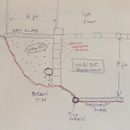Polyurethane grout for CMU blocks and gravel — waterproofing nightmare
drmario
| Posted in General Questions on
Hi all,
I’m working to resolve a complex water issue in a space we’re in the midst of renovating. In brief, part of our house is constructed on solid ledge (genuine Connecticut granite). Our basement walls are made of hollow concrete blocks. To address the issue, we excavated down to the footing, sealed the walls below grade with spray-grade bitumen, installed a Dorken Delta drainage mat, and added a French drain. However, there was a significant oversight: our contractor placed the drain about 1 ft above the lowest point, claiming he couldn’t grade it any differently. Subsequently, he backfilled the affected area with large gravel and then laid a slab over it (coinciding with our decision to move the front door about 6 ft outward). The outcome has been far from ideal. Due to the gravel layer, water is now directed to the lowest point beside the footing. There, it accumulates and seeps in because the French drain sits approximately 12 inches higher (please refer to the attached drawing).
I’m considering several potential solutions:
1) Drilling large 2″ weep holes from the interior at the base of the blocks to channel water into a drainage system that exits to the daylight (or to an existing sump).
2) Filling all the blocks with cementitious grout and subsequently injecting polyurethane grout at high pressure into each cavity. This aims to reinforce the blocks and reduce their porosity.
3) Also considering the injection of polyurethane grout into the gravel beneath the front door. This would act as a barrier against water attempting to flow down the ledge to the wall.
The optimal solution would be re-excavation to properly position the French drain lower, even if it means chiseling the ledge. However, this option is off the table due to significant new framing placed on the recently-poured slab.
Also, there is a sump in the basement and the tile drain around basement slab, but really trying to stop water penetration as much as possible.
Does anyone have innovative solutions or advice?
GBA Detail Library
A collection of one thousand construction details organized by climate and house part
Search and download construction details










Replies
Don't know about #1 or #2, but I would be leery of #3. You run a high probability of blocking the drain pipe holes when you inject poly grout, then you will have a bigger problem.
Even if your contractor had placed the exterior drain directly on the ledge it appears that you would have the same problem due to the exposed ledge on the interior. Could you cover the interior ledge with a poured concrete shelf and allow the interior drain to handle the water?